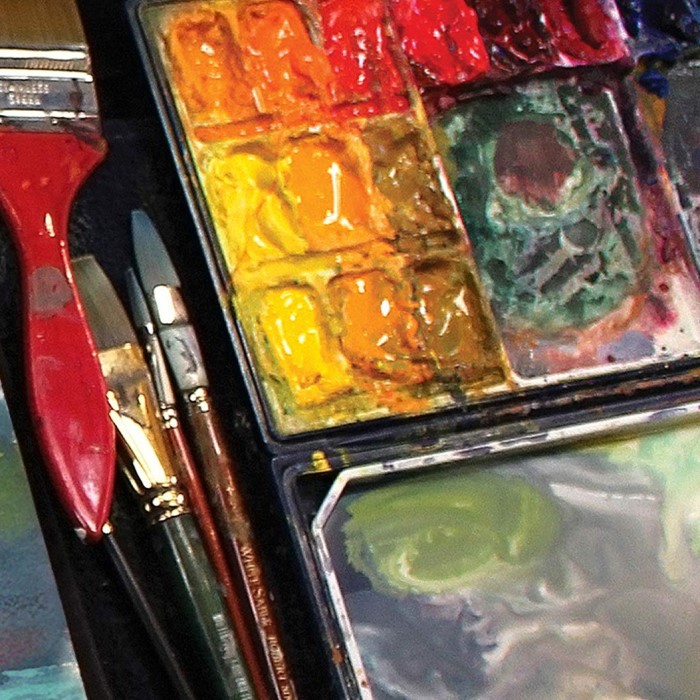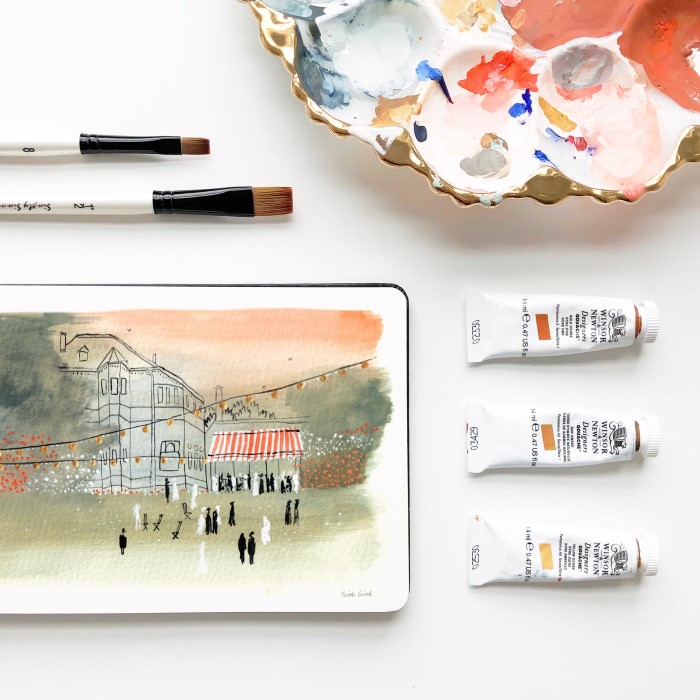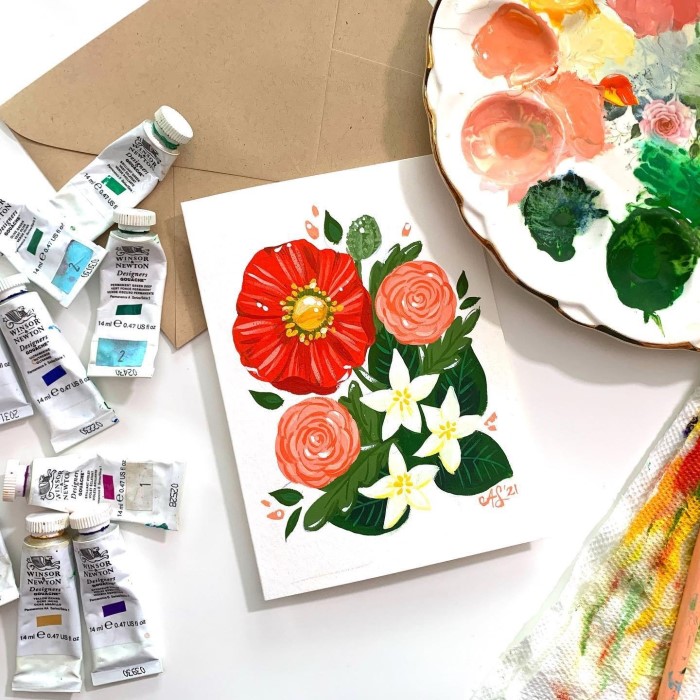Introduction
If you’re looking to elevate your painting skills, learning how to paint with gouache is an excellent choice. Gouache, known for its vibrant colors and versatility, allows artists to create stunning works with depth and texture. Unlike watercolor, gouache is opaque and can be used to create both delicate washes and bold strokes. In this article, we’ll explore various techniques to help you master gouache painting, focusing on methods that can enhance texture and add depth to your artwork. By the end of this guide, you’ll be equipped with the skills to create beautiful gouache paintings.

What is Gouache?
Gouache is a versatile and water-based paint used by artists for centuries. It contains pigments, water, and a binding agent like gum arabic. Gouache is often described as a mix between watercolor and acrylic. Artists love it for its vibrant colors and easy application.
Characteristics of Gouache Paint
Gouache paint has unique features that make it stand out:
- Opacity: Unlike watercolor, gouache is highly opaque, covering surfaces with solid colors.
- Reactivatable: Dried gouache can be reactivated with water for further adjustments.
- Matte Finish: It dries to a smooth, non-reflective surface, creating a soft appearance.
- Adjustable Consistency: You can dilute it with water for lighter effects or use it thick for bold strokes.
- Fast Drying: Gouache dries quickly, making it ideal for layering or speedy work.
These qualities make gouache suitable for illustrations, posters, and fine art projects.
How Gouache Differs from Other Mediums
Gouache shares similarities with watercolors and acrylics but differs in key ways:
- Compared to Watercolor: Gouache is more opaque and has a matte finish, while watercolor is transparent.
- Compared to Acrylic: Acrylics are permanent once dry, but gouache can be reactivated with water.
- Blending and Layering: Gouache allows easy blending and layering, unlike the often rigid drying of acrylics.
- Surface Suitability: Gouache works best on heavyweight paper, while acrylics are versatile on multiple surfaces.
Understanding these differences will help you choose gouache when the project needs bold, smooth colors and flexibility.
Essential Supplies for Painting with Gouache
Before starting with gouache, gathering essential supplies is crucial. Having the right materials ensures a smoother painting process and better results. Let’s dive into the essentials.
Choosing the Right Gouache Paints
Selecting quality gouache paints impacts your artwork’s vibrancy and durability. Here’s what to keep in mind:
- Student vs. Artist Grade: Artist-grade paints have more pigment, offering richer colors than student-grade.
- Color Range: Begin with a basic set of primary colors, black, and white.
- Reputable Brands: Popular gouache brands include Winsor & Newton, Holbein, and M. Graham.
- Tube or Pan: Gouache typically comes in tubes for easy mixing, but pans can also work.
Starting with a small set and expanding as needed is a smart approach for beginners.
Recommended Brushes and Tools
Choosing the right brushes and tools is as important as selecting paints. Here are key tips:
- Brush Types: Use synthetic or natural hair brushes. Round brushes work well for details, while flat brushes are better for wide strokes.
- Sizes: Have a variety—small (for details), medium (general use), and large (broad strokes).
- Palette: A ceramic or plastic palette helps with mixing colors effectively.
- Water Containers: Keep two containers—one for cleaning brushes and one for fresh water.
- Rags or Paper Towels: Use these for blotting or cleaning brushes during painting.
Investing in quality brushes ensures better control and longevity.
Surfaces Suitable for Gouache Painting
The right surface enhances gouache’s performance and look. Consider these options:
- Watercolor Paper: Heavyweight (140 lb or higher) prevents warping and handles layers well.
- Mixed Media Paper: Works for light gouache applications and mixed techniques.
- Boards: Illustration boards or hot-press paper provide a smooth surface ideal for details.
- Canvas: Gouache isn’t traditionally used on canvas but can work with a suitable primer.
Always test your gouache on small swatches before finalizing the surface. This ensures compatibility and desired results.
Preparation Before Painting
Preparing properly before painting with gouache can ensure better results. A well-organized workspace, good paint preparation, and effective color testing make the process enjoyable and productive.
Setting Up Your Workspace
An efficient workspace is key for a smooth artistic experience. Here’s how to set it up:
- Clean Surface: Use a sturdy table free of dust or clutter.
- Good Lighting: Ensure natural or bright light for accurate color perception.
- Ventilation: A well-ventilated room keeps the environment comfortable.
- Essential Tools Access: Keep brushes, gouache paints, water containers, and palettes within easy reach.
- Protection: Cover your table with a cloth or plastic to prevent stains.
Proper organization minimizes interruptions and improves focus while painting.
Mixing and Diluting Gouache Paints
Gouache is versatile and can be adjusted before applying to your surface. Learn how to mix and dilute it:
- Use a Palette: Mix colors on a ceramic or plastic palette for smooth blending.
- Dilution with Water: Add drops of water to achieve the consistency you need, from thick to thin.
- Scraping Technique: For dry paint in tubes, scrape it onto the palette and moisten it.
- Test Mix Ratios: Experiment with different water-to-paint ratios for your desired opacity.
- Avoid Overusing Water: Excess water weakens the paint’s opacity and adhesion.
Prepared gouache paints ensure seamless application and control during painting.
Test Your Color Palette
Testing your color palette is vital for achieving the desired look in your artwork:
- Create Swatches: Paint small swatches of each color on scrap paper.
- Blend Colors: Test how well colors blend for smooth transitions.
- Layer Tests: Try layering colors to check if they interact as expected.
- Opacity Check: Observe how thick and diluted paints look on the surface.
- Record Recipes: Keep notes of mixed colors for future consistency.
Testing helps you avoid surprises and ensures your colors work harmoniously in your final painting.
Basic Techniques for Gouache Painting
Mastering gouache techniques is essential for creating stunning artworks. From layering to blending, these methods can elevate your painting and improve your control over this versatile medium.
Layering and Blending
Layering and blending make gouache painting rich and dynamic. Here’s how to do them effectively:
- Start with Thin Layers: Begin with diluted gouache to create a base layer.
- Let Layers Dry Fully: Dry layers prevent unwanted mixing or smudging.
- Gradual Build-Up: Add thicker layers for depth; work from light to dark tones.
- Blend While Wet: Merge colors using clean brushes or water for smooth gradients.
- Use Controlled Strokes: Apply even strokes to create seamless transitions between colors.
Practice will refine your layering approach for intricate details and blended hues.
Achieving Opaque and Transparent Effects
Gouache’s versatility allows both opaque and transparent effects. Follow these tips to balance these:
- Opaque Application: Use thicker paint straight from the tube for solid coverage.
- Transparent Washes: Mix gouache with water to achieve light and airy effects.
- Layer Mixing: Combine opaque and transparent layers for interesting contrasts.
- Brush Control: Use soft brushes to control paint thickness effectively.
- Test Before Applying: Experiment on scrap paper to understand the opacity levels.
These effects help you add dimension and texture to your painting.
Using Dry Brush Techniques
Dry brushing adds texture and intricate details to gouache. Here’s how to execute it:
- Remove Excess Paint: Dab your brush on paper towel to reduce moisture.
- Light Pressure: Apply minimal pressure to prevent overloading the surface.
- Short Strokes: Use precise, quick strokes for rough textures or highlights.
- Experiment with Brushes: Use stiff bristles for pronounced textures and soft ones for subtle effects.
- Highlighting Details: Dry brushing works great for edges or adding depth in certain areas.
This technique can make your work look polished and distinctive.
By mastering these gouache techniques, you’ll gain confidence and flexibility for all artistic projects.
Creating Your First Gouache Artwork
How to paint with gouache? Embarking on your first gouache painting can be exciting yet challenging. Follow these tips to create a stunning piece.
Step-by-Step Guide to Start Painting
- Plan Your Subject: Choose a simple subject like flowers or landscapes.
- Sketch Lightly: Use a pencil to lightly sketch the outline on your chosen surface.
- Prepare Paints: Mix and dilute gouache colors to match your vision.
- Start with Base Layers: Apply thin, transparent layers for the background.
- Build Details Gradually: Let base layers dry and add thicker paint for details.
- Blend Carefully: Use clean brushes to blend colors for smooth transitions.
- Finalize with Highlights: Add bright strokes for highlights and texture.
- Review Your Work: Step back and evaluate areas needing adjustment or enhancement.
Common Mistakes and How to Avoid Them
- Overusing Water: Excess water weakens opacity and ruins the matte look. Test before applying.
- Skipping Layer Drying: Smudges happen when you paint over wet layers. Let layers fully dry.
- Not Testing Colors: Unplanned colors might clash. Always test blends or swatches first.
- Applying Thick Paint Too Early: Thick strokes can overwhelm delicate details. Work progressively.
- Ignoring Brush Size: Big brushes won’t work for tiny details. Match brush size to your needs.
Tips for Developing Your Style
- Experiment Regularly: Try varying techniques such as dry brushing or layering.
- Study Other Artists: Learn from gouache painters to understand different approaches.
- Mix Unique Colors: Don’t rely solely on primary colors. Create your own combinations.
- Play with Effects: Practice balancing opaque and transparent layers for depth.
- Focus on Practice: Paint frequently to build confidence and refine your style.
By following these steps and tips, you’ll enjoy your journey with gouache while developing unique artistry.
Caring for Your Gouache Paintings
How to paint with gouache? Proper care ensures your gouache artworks stay vibrant and long-lasting. Gouache is delicate and needs specific handling to maintain its quality over time.
Proper Storage Techniques
Storing gouache paintings correctly protects them from damage. Follow these techniques:
- Keep Paintings Flat: Store them flat to avoid bending or curling.
- Use Protective Sleeves: Place artworks in clear plastic sleeves to shield against dirt and moisture.
- Avoid Direct Sunlight: Sunlight can fade colors over time. Store pieces in a shaded area.
- Maintain Low Humidity: High humidity can cause mold or affect the paper’s quality.
- Separate Layers with Paper: Use acid-free paper between artworks to prevent sticking or smudging.
- Protect Edges: Frame or mount paintings to shield edges from wear and tear.
These steps will preserve your gouache paintings for years.
Fixative Options for Gouache Works
Fixatives can offer added protection to your gouache paintings. Though not always necessary, they help in specific situations:
- Thin Layers of Fixative: Avoid thick sprays, as they might alter the matte finish.
- Choose the Right Product: Use workable fixatives designed for water-based media.
- Spray Evenly: Hold the spray can 12 inches away for even application.
- Test Before Use: Test the fixative on a small, inconspicuous section first.
- Reapply When Needed: Apply additional layers for artworks handled frequently.
Many artists skip fixatives to retain gouache’s natural texture. Decide based on your artwork’s purpose and durability requirements.
By storing your gouache paintings properly and considering fixatives, you can safeguard their original beauty.
Advanced Gouache Tips and Tricks
Gouache offers immense possibilities for advanced artists. Discover creative ways to use gouache effectively.
Using Gouache for Illustrations and Designs
Gouache is ideal for detailed illustrations and graphic design projects. Here’s how:
- Create Bold Colors: Use gouache’s opaque nature for bright and vibrant designs.
- Enhance Textures: Layer gouache to add depth and texture to your illustrations.
- Work on Smooth Surfaces: Choose hot-pressed paper or illustration boards for crisp details.
- Use Thin Brushes: Thin brushes help achieve intricate outlines and sharp edges.
- Flat Color Application: Apply gouache evenly for professional, clean graphic designs.
- Experiment with Line Art: Combine gouache with ink for striking mixed-media artworks.
These techniques can elevate your designs and make them visually engaging.
Combining Gouache with Other Art Mediums
How to paint with gouache? Mixing gouache with other mediums expands its unique appeal. Try these combinations:
- Gouache with Watercolor: Blend gouache with watercolor for transparent and opaque layers.
- Gouache and Colored Pencils: Add fine details and textures using colored pencils after gouache dries.
- Gouache and Acrylics: Use gouache for flexibility and layer it with permanent acrylics for bold contrasts.
- Ink Accents: Use ink for outlines or highlights alongside gouache’s smooth finish.
- Charcoal Integration: Add charcoal marks for dynamic textures or shading over gouache.
- Mix Media Papers: Combine techniques on mixed-media paper for experimental compositions.
Exploring mixed techniques helps you unlock the full potential of gouache in your creations.
Conclusion
In conclusion, learning how to paint with gouache opens up a world of creative possibilities. With its unique characteristics, gouache allows artists to explore various techniques for adding texture and depth to their works. By mastering essential and advanced techniques while maintaining your materials, you can produce stunning artwork that reflects your individuality. Embrace your artistic journey with gouache, and don’t be afraid to experiment and develop your unique style. Happy painting!



